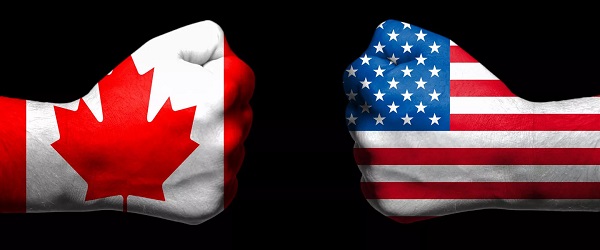Business
Trump’s trade war and what it means for Canada

From the Fraser Institute
We didn’t want it but it has crashed onto our shores anyway. U.S. President Donald Trump has unleashed his long-mooted assault on Canada, deploying tariffs as his chosen weapon of “economic coercion.” The Executive Order justifying 25 per cent across-the-board tariffs on southbound Canadian exports (10 per cent on exports of energy and critical minerals) cites American concerns over cross-border drug shipments. Yet that can hardly be the real reason for Trump’s unprecedented action. Canada is at most a tiny part of America’s festering problem of widespread illegal drug use. The notion that these punitive tariffs are mainly about compelling Canada to clamp down on fentanyl production is far-fetched.
It is obvious that this most unconventional of American presidents has other aims in mind. One may be to impose steep tariffs on all or most imports entering his country as a means to raise money for the cash-strapped U.S. treasury. A second may be to suck industrial production and capital out of Canada and other trading partners, to support the MAGA movement’s objective of rebuilding American manufacturing. In his remarks delivered (virtually) to the good and the great assembled at the World Economic Forum’s shindig in Davos in January, President Trump put much emphasis on this latter point. Or perhaps what the new U.S. administration most wants is to convince Canada (and other trading partners) to align with American policies to de-couple from and slow the economic and military ascent of China.
If some or all of these are indeed Mr. Trump’s most important goals, it will be difficult for Canada to negotiate our way out of the bilateral trade war. As hard as it may be to imagine, Trump’s tariffs–with the possibility of even higher levies and various other trade restrictions still to come–could be the new “normal” for Canada, at least for the duration of his presidency. For the moment, the trilateral Canada-U.S.-Mexico trade agreement is either dead or at best barely clinging to life.
As the tariff war gets underway, it is useful to look at the composition of Canada-U.S. trade. Most of it involves cross-border trade in “intermediate inputs,” not finished goods or final products (see the accompanying table). More than three-fifths of Canada’s U.S.-bound exports consist of energy, building materials, agri-food products, other raw materials, and other items used to produce final goods. Similarly, over half of all U.S. goods shipped to Canada are also made up of intermediate inputs. Capital goods (e.g., machinery and equipment) represent 16 to 23 per cent of bilateral merchandise trade. Final goods constitute between a fifth and a quarter of the total. This underscores the highly integrated nature of North American supply chains–and the significant disruptions that two-way tariffs will cause for many industries operating on both sides of the border.
| Composition of Canada-U.S. Merchandise Trade, 2023 (% of total exports) | ||
|---|---|---|
| Canadian exports to the U.S. | U.S. exports to Canada | |
| Final goods | 21% | 25% |
| Capital goods* | 16% | 23% |
| Intermediate inputs | 63% | 52% |
*e.g., machinery and equipment
Source: Canadian Chamber of Commerce, Data Lab.
Looking ahead, it’s clear our economy is about to suffer, as Canadian industries, workers and communities absorb the biggest external shock in a century (apart from during the initial phases of the COVID pandemic). To see why, recall that the U.S. buys more than three-quarters of Canada’s international exports, with the value of our U.S.-destined shipments amounting to about one-fifth of Canada’s GDP.
According to projections published by the Bank of Canada, 25 per cent U.S. tariffs coupled with Canadian retaliatory tariffs will reduce the level of Canadian real GDP by at least 3 per cent over 2025-26–this represents a permanent output loss, meaning it is national income we will never recoup. Business fixed non-residential investment falls by 12 per cent, with exports dropping by nine per cent. Unemployment rises significantly and job creation downshifts. Consumer spending also weakens–in part because retaliatory Canadian tariffs raise the cost of many consumer goods, thus leading to a temporary bump in Canadian inflation. All of these estimates are measured relative to a counterfactual baseline scenario of no U.S. and Canadian tariffs. The U.S. economy will also take a hit from President Trump’s tariffs, notably through higher inflation, increased business uncertainty, and the costs of rejigging the supply chains of American companies that rely significantly on raw materials, other inputs and consumer goods supplied by Canada and Mexico.
How should Canada respond to the American tariffs? An initial priority is to determine if there is a pathway to a negotiated settlement–not a simple task, as the Americans have yet to specify what it would take to make peace. A second option is to hit back. Canada has already announced a schedule for retaliatory tariffs, covering some $155 billion of goods imported from the United States; all of these are slated to be in place by the end of March. While the political impulse and pressure to respond in kind is understandable, retaliation will magnify the economic damage to Canada from the U.S. tariffs. Finding a way to end the conflict–if that is possible–is far superior to a series of tit-for-tat bilateral tariffs.
Some politicians and media commentators have talked up “trade diversification” as an option for Canada. Reduced reliance on the U.S. would likely deliver benefits in the long-term, but it won’t help us in 2025/26. Despite entering into 15 trade agreements with 51 nations (other than the U.S.), Canada has seen virtually no export market diversification in the last two decades. There has been modest diversification on the import side of the trade ledger, mainly due to the growing importance of China and other Asian emerging markets as suppliers of final goods and some intermediate inputs. But the U.S. remains the source of more than half of Canada’s imports of goods and services combined. Moreover, “gravity models” of international trade confirm that Canada’s dense, extensive web of trade and other commercial ties with the United States makes perfect economic sense given the advantages of geographic proximity, a common language, and similar business practices between the two countries.
The Trump administration’s self-chosen trade war is a watershed moment for Canadian foreign and commercial policy. The shock from this U.S. action will persist, even if the tariffs are in place for only a few months. Treating an ally as an enemy is an abnormal practice in the history of Western diplomacy. But with Donald Trump at the helm, the past is no longer a reliable guide to understanding or forecasting American policy.
2025 Federal Election
Does Canada Need a DOGE?

From the Fraser Institute
By Philip Cross
The legions of Canadians wanting to see government spending shrink probably look enviously at how Elon Musk’s Department of Government Efficiency (DOGE) is slashing some government programs in the United States, even if DOGE’s non-surgical chainsaw approach is controversial, to say the least.
Some problems are common to cutting any government’s spending. Ironclad job security for union employees with seniority means cuts are skewed disproportionately to junior staff still on probation, with the regrettable side effect of denying an injection of fresh blood into a sclerotic workforce. Cutting employees and not programs makes it easier for higher staffing to resume: as documented by Carleton University Professor Ian Lee in How Ottawa Spends, even prolonged bouts of austerity do not derail government spending from long-term trend of higher growth. Across the board cuts do not allow for the surgical removal of redundant or inefficient programs and poor performing employees.
Canada has some unique problems with federal government spending. Savoie documents how 41 per cent of federal civil servants are located in Ottawa, versus 16 per cent in Washington and 19 per cent in London, despite Canada having the most decentralized federation in the G7. The concentration in Ottawa partly reflects the exceptional influence exerted by central agencies on all departments. As well, University of Cambridge Professor Dennis Grube found Canada’s civil service was the most resistant to public scrutiny and the most risk adverse in a comparative study of public servants in the U.S., the United Kingdom, Australia, New Zealand and Canada.
Canada’s federal employees are among the most expensive anywhere. The average civil servant costs taxpayers $146,500 a year including all salary, benefits and costs such as computers and training. Multiplying this average cost by 366,316 federal employees yields a total labour bill of $53.7 billion, not including other spending such as $17.8 billion on consultants. All the recent increase in the ranks of the civil service happened in Justin Trudeau’s tenure, expanding 38.5 per cent after Stephen Harper had cut them 9 per cent between 2010 and 2015 in his determination to balance the budget.
While the cost of government employees has risen sharply, the services they provide to the public are dwindling as government spending increasingly is devoted to managing its unwieldy and bloated bureaucracy. As Savoie observes, unions like to paint civil servants as providing essential services such as food inspectors and rescue workers, when in reality most are involved in a vast web of “policy, coordination, liaison, and performance evaluation units.” The fastest growing occupations in the federal government are in administrative services and program administration, whose share of jobs rose from 25.1 per cent in 2010 to 31.9 per cent in 2023 according to the latest report from the Treasury Board.
A chronic problem is the fierce defense offered by public service unions in “protecting non-performers and insulating the public sector from effective outside scrutiny” as Savoie wrote. The refusal to acknowledge and root out non-performers depresses the morale of the average civil servant who’s unfairly tarred with the reputation of a minority. It also motivates the across-the-board chainsaw approach of DOGE, which critics then decry as not discriminating between good and bad employees. The latter could easily be targeted by senior managers, who know exactly who the non-performers are but cannot be bothered with the years of documentation and bureaucratic headaches needed to get rid of them. The cost of poor performers is substantial; if even 10 per cent of the civil service was eliminated as redundant non-performers, the government would save $5.4 billion a year. Potential savings are likely well over $10 billion.
The federal government potentially has enormous leverage in negotiating civil service pay and getting rid of non-performers, because it can unilaterally change the federal pension plan without negotiating with public-sector unions. The federal pension plan is so generous that it’s referred to as the “golden handcuffs” that tie employees to their jobs irrespective of their pay or working conditions. To protect their lucrative pensions, unions inevitably would be willing to make concessions that substantially lower the burden on Canada’s taxpayers and still improve morale within the civil service.
2025 Federal Election
Don’t double-down on net zero again

From the Fraser Institute
In the preamble to the Paris Agreement, world leaders loftily declared they would keep temperature rises “well below 2°C” and perhaps even under 1.5°C. That was never on the cards—it would have required the world’s economies to effectively come to a grinding halt.
The truth is that the “net zero” green agenda, based on massive subsidies and expensive legislation, will likely cost more than CAD$38 trillion per year across the century, making it utterly unattractive to voters in almost every nation on Earth.
When President Trump withdrew the United States from the Paris Climate Agreement for the first time in 2017, then-Canadian Prime Minister Justin Trudeau was quick to claim the moral high ground, declaring that “we will continue to work with our domestic and international partners to drive progress on one of the greatest challenges we face as a world.”
Trudeau has now been swept from the stage. On his first day back in office, President Trump signed an executive order that again begins the formal, twelve-month-long process of withdrawing the United States from the Paris Agreement.
It will be tempting for Canada to step anew into the void left by the United States. But if the goal is to make effective climate policy, whoever is Canada’s prime minister needs to avoid empty virtue signaling. It would be easy for Canada to declare again that it’ll form a “coalition of the willing” with Europe. The truth is that, just like last time, that approach would do next to nothing for the planet.
Climate summits have generated vast amounts of attention and breathless reporting giving the impression that they are crucial to the planet’s survival. Scratch the surface, and the results are far less impressive. In 2021, the world promised to phase-down coal. Since then, global coal consumption has only gone up. Virtually every summit has promised to cut emissions but they’ve increased almost every single year, and 2024 reached a new high.
Way before the Paris Agreement was inked, the Kyoto Protocol was once sold as a key part of the solution to global warming. Yet studies show it achieved virtually nothing for climate change.
In the preamble to the Paris Agreement, world leaders loftily declared they would keep temperature rises “well below 2°C” and perhaps even under 1.5°C. That was never on the cards—it would have required the world’s economies to effectively come to a grinding halt.
The truth is that the “net zero” green agenda, based on massive subsidies and expensive legislation, will likely cost more than CAD$38 trillion per year across the century, making it utterly unattractive to voters in almost every nation on Earth.
The awkward reality is that emissions from Canada, the EU, and other countries pursuing climate policies matter little in the 21st century. Canada likely only makes up about 1.5 per cent of the world’s emissions. Add together Canada’s output with that of every single country of the rich-world OECD, and this only makes up about one-fifth of global emissions this century, using the United Nations’ ‘middle of the road’ forecast. The other four-fifths of emissions come mostly from China, India and Africa.
Even if wealthy countries like Canada impoverish themselves, the result is tiny — run the UN’s standard climate model with and without Canada going net-zero in 2050, and the difference is immeasurable even in 2100. Moreover, much of the production and emissions just move to the Global South—and even less is achieved.

One good example of this is the United Kingdom, which—like Prime Minister Trudeau once did—has leaned into climate policies, suggesting it would lead the efforts for strong climate agreements. British families are paying a heavy price for their government going farther than almost any other in pursuing the climate agenda: just the inflation-adjusted electricity price, weighted across households and industry, has tripled from 2003 to 2023, mostly because of climate policies. This need not have been so: the US electricity price has remained almost unchanged over the same period.
The effect on families is devastating. Had prices stayed at 2003 levels, an average family-of-four would now be spending CAD$3,380 on electricity—which includes indirect industry costs. Instead, it now pays $9,740 per year.
Rising electricity costs make investment less attractive: European businesses pay triple US electricity costs, and nearly two-thirds of European companies say energy prices are now a major impediment to investment.
The Paris Treaty approach is fundamentally flawed. Carbon emissions continue to grow because cheap, reliable power, mostly from fossil fuels, drives economic growth. Wealthy countries like Canada, the US, and European Union members have started to cut emissions—often by shifting production elsewhere—but the rest of the world remains focused on eradicating poverty.
Poor countries will rightly reject making carbon cuts unless there is a huge flow of “climate aid” from rich nations, and want trillions of US dollars per year. That won’t happen. The new US government will not pay, and the other rich countries cannot foot the bill alone.
Without these huge transfers of wealth, China, India and many other developing countries will disavow expensive climate policies, too. This potentially leaves a rag-tag group led by a few Western European progressive nations, which can scarcely afford their own policies and have no ability to pay off everyone else.
When the United States withdrew from the Paris Agreement in 2017, Canada’s doubling down on the Paris Treaty sent the signal that it would be worthwhile spending hundreds of trillions of dollars to make no real difference to temperatures. We fool ourselves if we pretend that doing so for a second time will help the planet.
We need to realize that fixing climate change isn’t about sanctimonious summits, lofty speeches, and bluster. In coming weeks I’ll outline the case for efficient policies like innovation, adaptation and prosperity.
-

 Business1 day ago
Business1 day agoTrump threatens additional 50% tariffs on China, urges ‘patience’
-

 Alberta1 day ago
Alberta1 day agoProvince introducing “Patient-Focused Funding Model” to fund acute care in Alberta
-

 2025 Federal Election11 hours ago
2025 Federal Election11 hours agoWATCH: Massive Crowd for Historic Edmonton Poilievre Rally
-

 Business2 days ago
Business2 days agoJury verdict against oil industry worries critics, could drive up energy costs
-

 International1 day ago
International1 day agoUN committee urges Canada to repeal euthanasia for non-terminally ill patients
-

 MacDonald Laurier Institute1 day ago
MacDonald Laurier Institute1 day agoRushing to death in Canada’s MAiD regime
-

 2025 Federal Election1 day ago
2025 Federal Election1 day agoMark Carney Comes to B.C. and Delivers a Masterclass in Liberal Arrogance
-

 2025 Federal Election11 hours ago
2025 Federal Election11 hours agoHarper Endorses Poilievre at Historic Edmonton Rally: “This Crisis Was Made in Canada”







